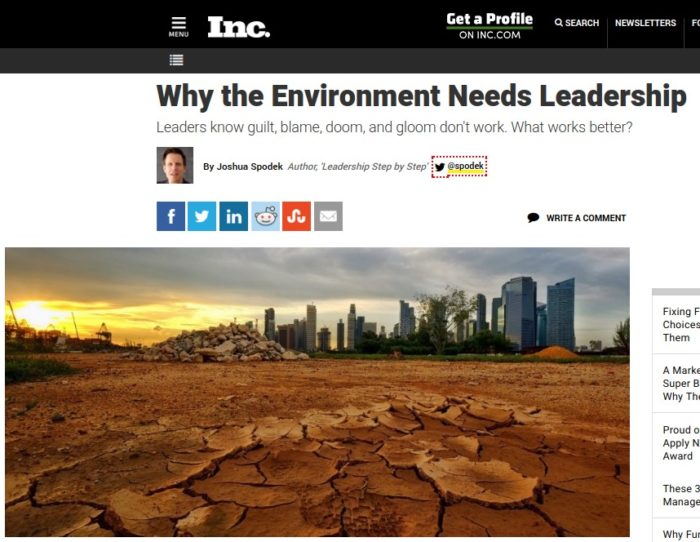
Why the Environment Needs Leadership
Leaders know guilt, blame, doom, and gloom don’t work. What works better?
Here’s one effective way to lead: Go where the people you want to lead are–emotionally, not necessarily physically. That is, learn what they care about and connect those motivations to the task. Then the task will feel meaningful and purposeful to them. They’ll do it for themselves. They’ll thank you for leading them to work.
What doesn’t work: telling people that their future is full of doom and gloom. Make them feel helpless and hopeless.
What also doesn’t work: debating about irrelevant issues, or even relevant ones. Logical debate rarely changes behavior.
Environmental action lacks leadership. I started my Leadership and the Environmentpodcast to fill the void. How people approach it gives us leadership lessons we who endeavor to lead better can all apply to our lives, especially regarding the environment.
What doesn’t lead
Six months ago, New York magazine published “The Uninhabitable Earth” by David Wallace-Wells that detailed many worst cases climate change might create. It began
It is, I promise, worse than you think. If your anxiety about global warming is dominated by fears of sea-level rise, you are barely scratching the surface of what terrors are possible, even within the lifetime of a teenager today.
The article went viral, even getting a Wikipedia page. Many columnists responded. While they likely all wanted to help the environment, I don’t think they did. I could be wrong about their intent. As writers, they may only have wanted to report.
Their approaches reveal two big problems would-be leaders commit, so we can learn from them.
The first problem is that when people care about a problem but can’t solve it, their emotions tend to get intense. Why? If you can solve a problem, you do. If you can’t, and you care about it, your mind won’t let go. As it exhausts its usual solutions it has to search further into uncharted territory–often meaning more intense emotions.
The second problem is focusing on yourself when you want to lead others. Effective leaders focus on those they want to lead, since the follower’s motivations, beliefs, and emotions motivate them, not the leader’s. Talking about doom, gloom, guilt, and blame usually come from frustration and impatience. The leader, venting.
Hearing a would-be leader full of gloom leads others to think, “They don’t look too happy. I’m happier than they are. I don’t want to be like that. I better keep away.” In other words, focusing on your motivations and venting makes others wary of you, decreasing your influence.
Examples
We don’t know if the writers below wanted to lead others, so they may have achieved other goals. But as leaders, we can see their strategies’ results from a leadership perspective and learn from them.
Slate‘s Science Editor, Susan Matthews, in “Alarmism Is the Argument We Need to Fight Climate Change” said the “global-warming horror story isn’t too scary. It’s not scary enough.” While fear, horror, and scaring people motivate, these emotions don’t lead. She doesn’t distinguish powerful motivation with effective motivation.
If a technique doesn’t work, amping up its intensity probably won’t work more.
Mother Jones’ Kevin Drum, in “Our Approach to Climate Change Isn’t Working. Let’s Try Something Else” appears to succumb to frustration. A solution he considers is “Pour massive amounts of public money into energy R&D and infrastructure buildout,” which sounds great, but how exactly do you do it? He concludes, in comparison to everything we’ve done, “We should try something different.” Great, but what?
Mashable‘s Senior Editor for Science and Special Projects, Kevin Freedman, in “No, New York Mag: Climate change won’t make the Earth uninhabitable by 2100” contrasts the story’s gloom against hope and optimism, but mostly analyses the science behind it. Nothing wrong with analyzing science, but facts rarely influence people’s behavior.
The Atlantic‘s Associate Editor, Robinson Meyer, asked, “Are We as Doomed as That New York Magazine Article Says?” He struggles to figure out how to talk about such a complicated problem.
The issue is what to do. The environment responds to our behavior, not our words.
Grist‘s Meteorologist, Eric Holthaus, in “Stop scaring people about climate change. It doesn’t work” documents the ineffectiveness and counterproductivity of scaring people, but suggests nothing better that talking about the problem. While talk may lead to a solution, it doesn’t solve anything.
Many people talk about the environment, but peer-reviewed research shows that
no significant difference is found between the impacts of environmentally aware and environmentally unaware consumers.
In other words, awareness and talk don’t mean changes in behavior.
Leadership lessons
Let’s learn from these articles. They came from places of genuine interest, but likely didn’t motivate people. Broadly speaking, they asked
- Should you use doom and gloom to motivate people?
- If doom and gloom don’t work, should you amplify the doom and gloom?
- Is the science behind it accurate?
If they wanted to motivate and lead, a more useful question would have been
- What works better than doom and gloom?
Effective leaders know what works better–start with your followers and their interests, beliefs, and values. What do they care about? How can you connect what they care about to the tasks at hand?
A personal note
Looking back, I realize I started Leadership and the Environment around when the article came out, though I only read it later. My strategy of
- Featuring influential people (not necessarily scientists, who rarely excel in leadership)
- Finding what they value about the environment,
- Inviting them to act on those values, and
- Having them share publicly their experiences for others to follow
is only beginning, but shows early promise. Most of the podcast guests say things like
It was challenging but I’m glad I did it. I wish I had done it earlier. Now that I have, I realize I can do more.
which sounds like they’re doing it for themselves and enjoying the change, at least after the initial challenge.
Let’s see if the practice leads others to follow.
